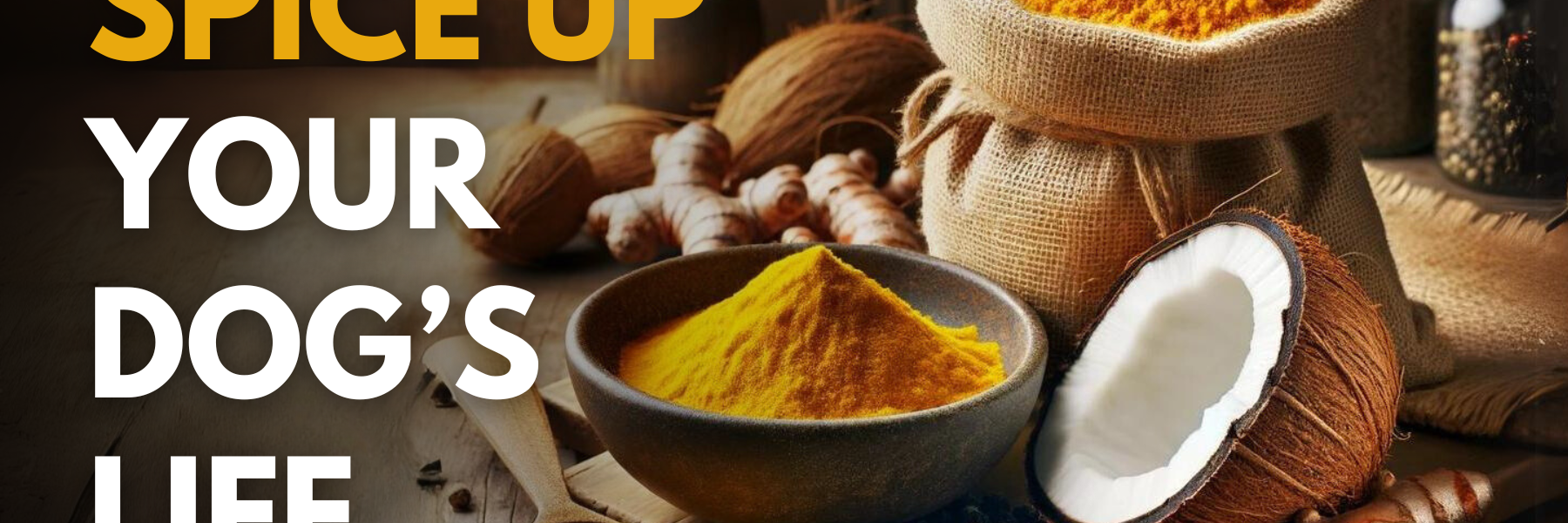Nature’s Synergy for your Dog’s Joint Health and Pain Management: 1+1 > 2
We love our dogs and want them to experience the joy of moving freely without pain. Dogs love being active which inevitably leads to injuries and also to “wear and tear” despite the best care and intentions.
As our dogs age, inflammation and arthritis are common, and so are discomfort, decline in mobility, and quality of life.
It is natural to worry about our dogs and to try to protect them from pain and inflammation. Unfortunately, these issues are often managed with NSAIDs (non-steroidal anti-inflammatory drugs), which can lead to frequent side effects such as stomach upset, gastrointestinal bleeding, damage to the liver and kidneys, and interference with the body’s own healing response.
How can we help our dogs enjoy activity without harm?
Fortunately, the answer to finding harmless and effective mobility enhancing foods and herbs exists in nature. These nutrients can deliver a synergy of benefits for healing and prevention, especially when combined in proper amounts and prepared for maximum absorption and efficacy.
The most commonly used therapies for canine joint health only focus on rebuilding collagen by using glucosamine and chondroitin. However, managing mobility issues in dogs requires a more complete solution that addresses muscles, joints, tendons, ligaments, synovial fluid, and the inflammation and pain that is associated.
For thousands of years, traditional medicine has turned to nature for remedies and chosen spices for their many healing properties. This ancient wisdom, supported by modern science, continues to highlight the significance of spices as the powerhouses of natural healing.
Golden Spice: Turmeric’s Healing Virtues and The Science Behind Them
You may have already heard of golden paste, a home remedy commonly used by dog lovers to reduce inflammation, help arthritis and heal injuries. You may also know that the primary ingredient in golden paste is turmeric, a spice used for thousands of years in traditional medicine as an anti-inflammatory and natural pain relief remedy.
Based on the growing body of research, several studies have now confirmed that turmeric is beneficial in managing arthritis and inflammation in dogs, much like in humans.
Here are several key reasons why turmeric is a canine mobility support superstar:
- Inflammation Reduction: One of turmeric’s active components, curcumin, has been shown to possess potent anti-inflammatory properties similar to NSAIDs without the side effects, making turmeric a safer longer term alternative. [5] [6] [10]
-
Cartilage Support: Turmeric can protect cartilage by inhibiting enzymes that contribute to cartilage degradation. This is very important in conditions like arthritis, where the preservation of cartilage is crucial for maintaining joint health and mobility. [7]
-
Pain Management: Clinical studies have demonstrated that turmeric is effective in relieving pain and improving mobility in dogs with osteoarthritis. Dogs supplemented with a diet containing turmeric showed improved ability to rise from a sitting or lying position, indicating pain relief and enhanced joint function. [4]
-
Arthritis Support: Research has demonstrated that turmeric is highly effective in improving osteoarthritis in canines. [12]
You can also read more about the benefits and science in my blog Turmeric for Dogs.
One important fact to remember!
While turmeric is an amazing superfood with numerous benefits, its use comes with several challenges when given on its own. [8]:
Is there a way of getting all the healing benefits that turmeric has to offer?
The answer is YES!
Black Pepper and Turmeric – best friends and fierce allies
Are you wondering how these two spices work together?
Imagine turmeric and black pepper as two happy dogs playing in the field of health and wellness. Turmeric is like a golden retriever – vibrant, full of life, and known for its loyalty in supporting the body’s well-being with its anti-inflammatory and antioxidant powers. It’s eager to fetch the benefits of health and bring them back to its owner, but sometimes, it runs too fast blowing away most of the turmeric on the way, barely bringing anything to the final destination.
Black pepper, is like a border collie, focused and smart, ensuring that everything is lined up to deliver the most turmeric to the final destination.
In fact, black pepper contains piperine, a compound that “herds” or delivers turmeric to the body’s muscles, joints and inflamed tissues. Piperine also slows down the metabolism of turmeric’s active compounds, which effectively increases the concentration to achieve the greatest medicinal effect.
Together, turmeric and black pepper make perfect partners. Where turmeric might struggle on its own, black pepper is right there to help, ensuring that the turmeric’s healing effects are not in vain.
The science behind the Turmeric and Black Pepper Duo:
-
Piperine, a major active component of black pepper, has been shown to increase the bioavailability of curcumin by inhibiting its metabolism, allowing higher concentrations of curcumin to remain in the body for longer periods. [8] [13]
Additional benefits of Black Pepper
-
Pain and Inflammation Support: The compound piperine plays a direct role in mitigating inflammation in animals and has been tested as a natural pain reliever in studies, suggesting a promising area for future research in pain management. [1] [3]
Other “side benefits”: Research also shows black pepper’s potential to promote gut health and may enhance the proliferation of beneficial gut bacteria which is important for immune function, mood regulation, and the prevention of chronic diseases. [2]
Preparation of Ingredients is as important as their selection
How we prepare ingredients matters as it has a direct effect on their efficacy and bio-availability.
-
Using Whole Spice: We start with whole turmeric and whole black pepper and do not fractionate and damage them by trying to isolate out the curcumin or the piperine. There are hundreds of other compounds (that also work synergistically within spices and plants). When you fractionate the isolated compounds, they behave more like drugs and cause side effects. We believe in the wisdom of nature and the harmony of medicinal plants and superfoods.
-
We use Fermentation, an ancient method blended with precise modern technology to enhance the bio-availability of ingredients and cultivate a wide spectrum of bioactive compounds that support digestion and nutrient absorption. This proprietary dual stage fermentation process enhances the effectiveness of turmeric and black pepper in JointButter, an advanced joint and mobility supplement for dogs.
Organic Coconut Oil – Why 2 + 1 is more than 3
Research has shown that combining turmeric, black pepper and coconut oil is much more potent than the sum of their parts. Together they not only address inflammation and pain but also support nutritional absorption and gut health. [8]
You can find these super spices in our JointButter® formula, in combination with 11 other ingredients designed to support a comprehensive approach to canine mobility.
We can’t wait to hear about the transformations you will witness with your dog.
References
-
Bang, J. S., Oh, D. H., Choi, H. M., Sur, B. J., Lim, S. J., Kim, J. Y., … & Kim, K. S. (2009). Anti-inflammatory and antiarthritic effects of piperine in human interleukin 1beta-stimulated fibroblast-like synoviocytes and in rat arthritis models. Arthritis Research & Therapy, 11(2), R49.
-
Butt, M. S., Pasha, I., Sultan, M. T., Randhawa, M. A., Saeed, F., & Ahmed, W. (2013). Black pepper and health claims: a comprehensive treatise. Critical Reviews in Food Science and Nutrition, 53(9), 875-886.
-
Tasleem, F., Azhar, I., Ali, S. N., Perveen, S., & Mahmood, Z. A. (2014). Analgesic and anti-inflammatory activities of Piper nigrum L. Asian Pacific Journal of Tropical Medicine, 7(Suppl 1), S461-S468.
-
Comblain, F., Barthélémy, N., Lefèbvre, M., Schwartz, C., Lesponne, I., Serisier, S., … & Henrotin, Y. (2017). A randomized, double-blind, prospective, placebo-controlled study of the efficacy of a diet supplemented with curcuminoids extract, hydrolyzed collagen and green tea extract in owner’s dogs with osteoarthritis. BMC Veterinary Research, 13(1), 395.
-
Kuptniratsaikul, V., Dajpratham, P., Taechaarpornkul, W., Buntragulpoontawee, M., Lukkanapichonchut, P., Chootip, C., … & Laongpech, S. (2014). Efficacy and safety of Curcuma domestica extracts compared with ibuprofen in patients with knee osteoarthritis: a multicenter study. Clinical Interventions in Aging, 9, 451-458.
-
Shahrajabian, M. H., & Sun, W. (2023). The Golden Spice for Life: Turmeric with the Pharmacological Benefits of Curcuminoids Components, including Curcumin, Bisdemethoxycurcumin, and Demethoxycurcumin. Current Organic Synthesis.
-
Mathy-Hartert, M., Jacquemond-Collet, I., Priem, F., Sanchez, C., Lambert, C., & Henrotin, Y. (2009). Curcumin inhibits pro-inflammatory mediators and metalloproteinase-3 production by chondrocytes. Inflammation Research, 58(12), 899-908.
-
Prasad, S., Tyagi, A. K., & Aggarwal, B. B. (2014). Recent Developments in Delivery, Bioavailability, Absorption and Metabolism of Curcumin: the Golden Pigment from Golden Spice. Cancer Research and Treatment, 46(1), 2–18.
-
Shoba, G., Joy, D., Joseph, T., Majeed, M., Rajendran, R., & Srinivas, P. S. (1998). Influence of piperine on the pharmacokinetics of curcumin in animals and human volunteers. Planta Medica, 64(4), 353-356.
-
Peng, Y., Ao, M., Dong, B., Jiang, Y., Yu, L., Chen, Z., … & Xu, R. (2021). Anti-Inflammatory Effects of Curcumin in the Inflammatory Diseases: Status, Limitations and Countermeasures. Drug Design, Development and Therapy, 15, 4503–4525.
-
Corbee, R. J. (2022). The efficacy of a nutritional supplement containing green‐lipped mussel, curcumin and blackcurrant leaf extract in dogs and cats with osteoarthritis. Veterinary Medicine and Science, 8(3), 1025–1035.
-
Sheahan, S. (2022). Efficacy of turmeric for treatment of osteoarthritis: A systematic review and meta-analysis of experimental animal model studies. American Journal of Traditional Chinese Veterinary Medicine, 17(1), 3-12.
-
Pratti, V. L., Thomas, M., Bhoite, R., & Satyavrat, V. (2024). Investigating Bioavailability of Curcumin and Piperine Combination in Comparison to Turmeric Rhizomes. Journal of Experimental Pharmacology, 16, doi.org/10.2147/JEP.S427818.








